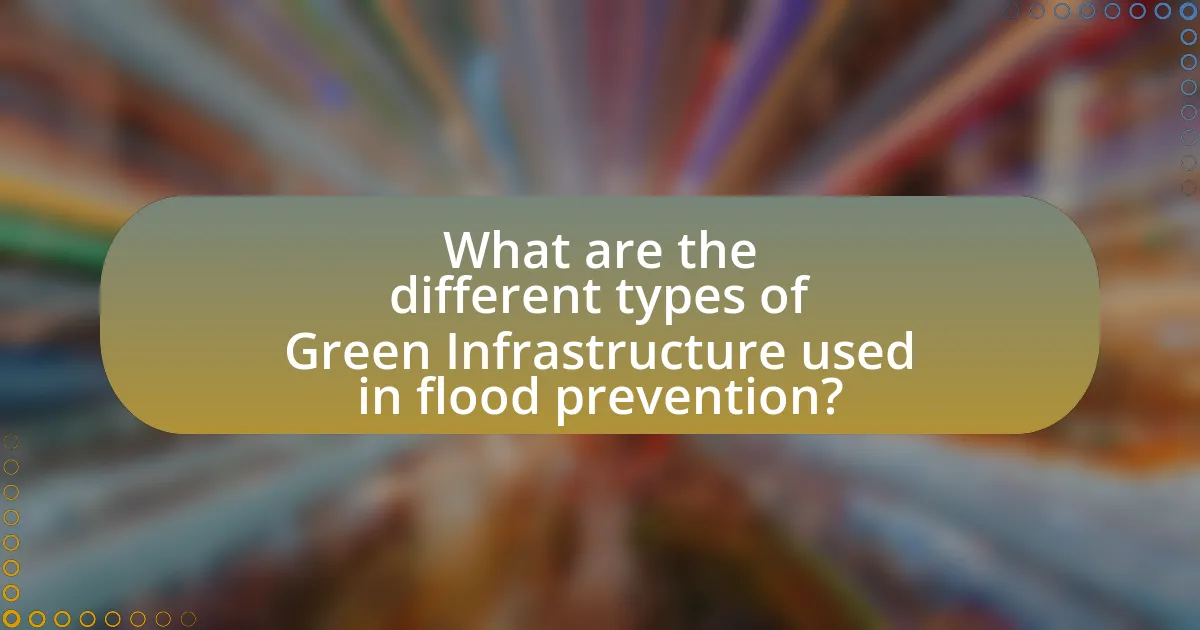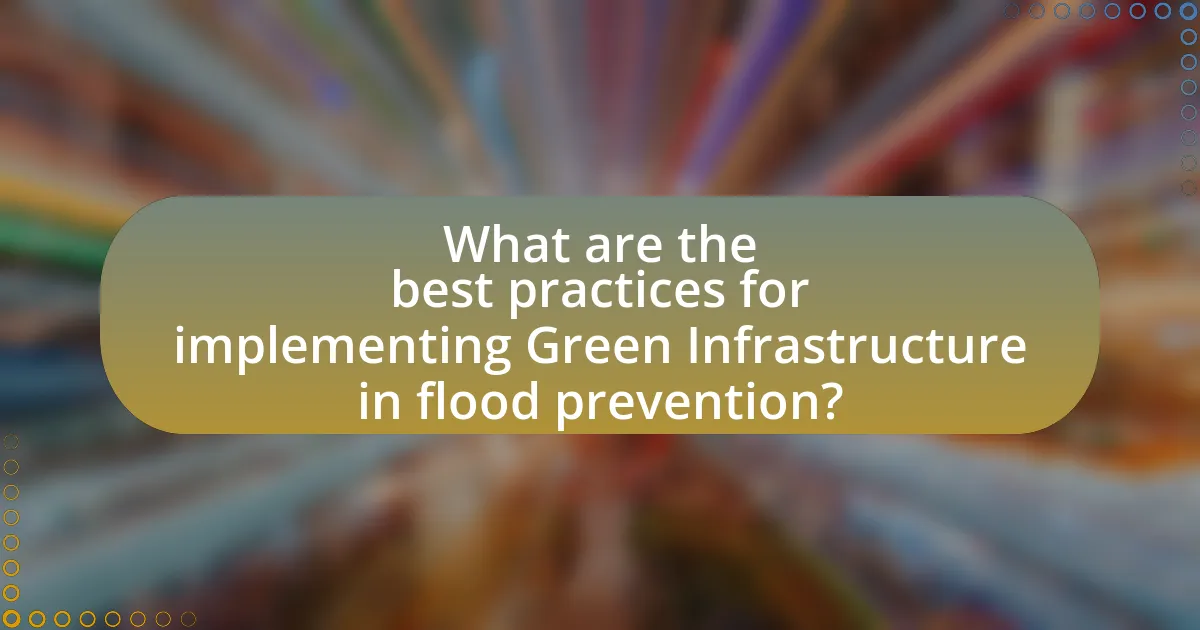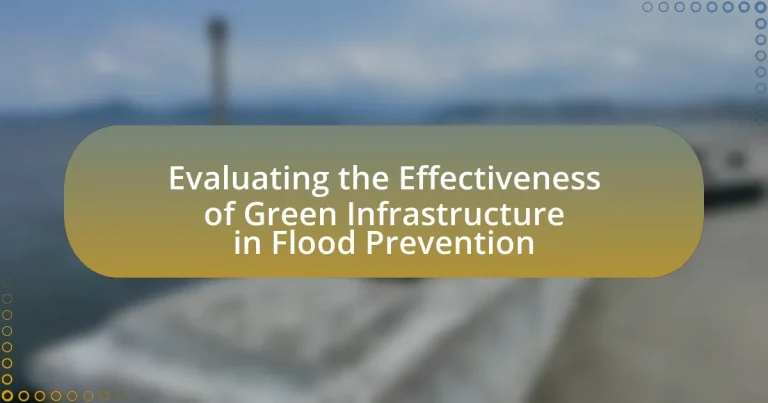The article focuses on evaluating the effectiveness of green infrastructure in flood prevention, highlighting its role in managing stormwater and reducing urban flooding risks. Key components such as green roofs, permeable pavements, rain gardens, and wetlands are discussed for their ability to absorb rainfall and mitigate runoff. The article emphasizes the importance of assessing performance metrics, including stormwater management and biodiversity enhancement, to inform flood prevention strategies. Additionally, it addresses challenges in evaluation, best practices for implementation, and the significance of community engagement and funding in enhancing the effectiveness of green infrastructure projects.

What is Green Infrastructure in the Context of Flood Prevention?
Green infrastructure refers to a network of natural and semi-natural systems designed to manage stormwater and reduce flooding risks. This approach utilizes features such as green roofs, permeable pavements, rain gardens, and wetlands to absorb and manage rainfall, thereby mitigating the volume and speed of runoff. Studies indicate that implementing green infrastructure can significantly decrease urban flooding; for instance, a report by the U.S. Environmental Protection Agency highlights that green roofs can reduce stormwater runoff by up to 65%. This evidence supports the effectiveness of green infrastructure in enhancing flood resilience in urban areas.
How does Green Infrastructure contribute to flood management?
Green Infrastructure contributes to flood management by enhancing natural water absorption and reducing surface runoff. This approach utilizes features such as green roofs, permeable pavements, and rain gardens to capture and manage stormwater effectively. For instance, studies have shown that green roofs can reduce stormwater runoff by up to 65%, significantly mitigating flood risks in urban areas. Additionally, the implementation of permeable surfaces allows rainwater to infiltrate the ground, replenishing groundwater and decreasing the volume of water that can lead to flooding.
What are the key components of Green Infrastructure for flood prevention?
The key components of Green Infrastructure for flood prevention include permeable surfaces, green roofs, rain gardens, and wetlands. Permeable surfaces allow water to infiltrate the ground, reducing runoff and promoting groundwater recharge. Green roofs absorb rainwater, decreasing the volume of water that reaches the ground. Rain gardens are designed to capture and filter stormwater, while wetlands act as natural sponges, absorbing excess water during heavy rainfall. These components collectively enhance water management and mitigate flood risks by promoting natural water absorption and reducing surface runoff.
How do these components interact to mitigate flooding?
Green infrastructure components, such as permeable pavements, green roofs, and rain gardens, interact synergistically to mitigate flooding by enhancing water absorption and reducing runoff. Permeable pavements allow rainwater to infiltrate the ground, decreasing surface runoff and promoting groundwater recharge. Green roofs absorb rainfall, reducing the volume of water that reaches the ground and delaying runoff. Rain gardens capture and filter stormwater, allowing it to percolate into the soil while also providing habitat for wildlife. Collectively, these components create a more resilient urban landscape, effectively managing stormwater and minimizing flood risks. Studies have shown that implementing green infrastructure can reduce peak runoff by up to 65%, demonstrating its effectiveness in flood prevention.
Why is evaluating the effectiveness of Green Infrastructure important?
Evaluating the effectiveness of Green Infrastructure is important because it determines how well these systems mitigate flooding and manage stormwater. Effective evaluation provides data on performance metrics such as water retention capacity, reduction in runoff, and overall impact on local ecosystems. For instance, studies have shown that green roofs can reduce stormwater runoff by up to 65%, demonstrating their significant role in flood prevention. By assessing these metrics, stakeholders can make informed decisions about investments, maintenance, and improvements to enhance resilience against flooding events.
What metrics are used to assess the effectiveness of Green Infrastructure?
Metrics used to assess the effectiveness of Green Infrastructure include stormwater management performance, biodiversity enhancement, and urban heat island mitigation. Stormwater management performance is evaluated through metrics such as runoff reduction, water quality improvement, and peak flow attenuation, which quantify the infrastructure’s ability to manage rainfall and reduce flooding risks. Biodiversity enhancement is measured by species richness and habitat quality, indicating how well the infrastructure supports various plant and animal species. Urban heat island mitigation is assessed through temperature reduction metrics, which demonstrate the cooling effects of green spaces compared to built environments. These metrics provide a comprehensive understanding of how Green Infrastructure contributes to flood prevention and overall environmental health.
How do these metrics influence flood prevention strategies?
Metrics such as rainfall intensity, soil saturation levels, and runoff rates directly influence flood prevention strategies by providing critical data for assessing flood risks. For instance, high rainfall intensity metrics can indicate the need for enhanced drainage systems, while soil saturation levels inform the capacity of green infrastructure to absorb excess water. Studies have shown that integrating these metrics into planning can reduce flood damage by up to 30%, as evidenced by the implementation of green roofs and permeable pavements in urban areas, which effectively manage stormwater runoff.

What are the different types of Green Infrastructure used in flood prevention?
The different types of Green Infrastructure used in flood prevention include green roofs, permeable pavements, rain gardens, bioswales, and urban forests. Green roofs absorb rainwater and reduce runoff, while permeable pavements allow water to infiltrate through surfaces, decreasing surface runoff. Rain gardens are designed to capture and filter stormwater, and bioswales are landscape elements that manage water runoff through vegetation and soil. Urban forests contribute to flood prevention by enhancing water absorption and reducing the speed of runoff. These methods collectively improve water management and mitigate flooding risks in urban areas.
How do green roofs function in flood management?
Green roofs function in flood management by absorbing and retaining rainwater, which reduces surface runoff. They consist of layers that include vegetation, soil, and drainage systems, allowing them to capture precipitation and gradually release it, thereby mitigating the risk of flooding. Studies have shown that green roofs can retain up to 75% of rainfall during peak events, significantly decreasing the volume of water that enters stormwater systems. This capacity for water retention not only helps manage flood risks but also contributes to improved water quality by filtering pollutants before they reach drainage systems.
What are the benefits of implementing green roofs in urban areas?
Implementing green roofs in urban areas provides multiple benefits, including improved stormwater management, enhanced biodiversity, and reduced urban heat island effects. Green roofs absorb rainwater, which can reduce runoff by up to 75%, thereby mitigating flooding risks during heavy rainfall events. Additionally, they create habitats for various species, promoting urban biodiversity. Furthermore, green roofs can lower ambient temperatures by up to 5 degrees Celsius, contributing to energy savings and improved air quality. These benefits collectively support urban resilience against climate change impacts, particularly in flood prevention scenarios.
What challenges are associated with green roofs in flood prevention?
Green roofs face several challenges in flood prevention, primarily related to their design, maintenance, and performance under extreme weather conditions. The limited water retention capacity of green roofs can lead to overflow during heavy rainfall, as they may not absorb all the excess water. Additionally, the effectiveness of green roofs can diminish over time due to soil compaction, plant health, and maintenance issues, which can reduce their ability to manage stormwater effectively. Research indicates that while green roofs can mitigate flooding, their performance is highly dependent on proper installation and ongoing care, as highlighted in studies such as “Green Roofs for Stormwater Management” by Getter and Rowe, which emphasizes the importance of design specifications and maintenance practices in achieving optimal flood prevention outcomes.
What role do permeable pavements play in flood mitigation?
Permeable pavements play a crucial role in flood mitigation by allowing water to infiltrate through the surface, reducing surface runoff. This infiltration helps to manage stormwater effectively, decreasing the volume and speed of water that can lead to flooding. Studies indicate that permeable pavements can reduce runoff by up to 50% compared to traditional impermeable surfaces, thereby lowering the risk of urban flooding during heavy rainfall events.
How do permeable pavements reduce surface runoff?
Permeable pavements reduce surface runoff by allowing water to infiltrate through their surface and into the underlying soil. This infiltration process decreases the volume of water that flows over the pavement, thereby mitigating flooding and erosion. Studies have shown that permeable pavements can reduce runoff by up to 50% compared to traditional impervious surfaces, as they facilitate groundwater recharge and decrease peak flow rates during rain events.
What are the maintenance requirements for permeable pavements?
Permeable pavements require regular maintenance to ensure their effectiveness in managing stormwater. This maintenance includes routine cleaning to remove debris, sediment, and organic matter that can clog the surface and reduce permeability. Studies indicate that vacuum sweeping is an effective method for cleaning permeable pavements, with recommendations suggesting this should occur at least once or twice a year, depending on the level of traffic and surrounding vegetation. Additionally, periodic inspections are necessary to assess the structural integrity and functionality of the pavement, allowing for timely repairs or replacements if needed. Regular maintenance not only enhances the lifespan of permeable pavements but also optimizes their role in flood prevention by maintaining their drainage capacity.

How is the effectiveness of Green Infrastructure evaluated?
The effectiveness of Green Infrastructure is evaluated through a combination of quantitative and qualitative assessments, including hydrological modeling, performance metrics, and monitoring of ecosystem services. Hydrological modeling quantifies the impact of Green Infrastructure on stormwater management, while performance metrics assess factors such as water quality improvement and flood reduction. Monitoring of ecosystem services, such as biodiversity enhancement and urban heat mitigation, provides additional insights into the overall effectiveness. Studies, such as those conducted by the U.S. Environmental Protection Agency, demonstrate that Green Infrastructure can reduce runoff by 30-50%, validating its role in flood prevention.
What methodologies are used to evaluate Green Infrastructure effectiveness?
Methodologies used to evaluate Green Infrastructure effectiveness include hydrological modeling, performance monitoring, and cost-benefit analysis. Hydrological modeling assesses how green infrastructure impacts water flow and quality by simulating various scenarios, which can be validated through historical data. Performance monitoring involves the collection of real-time data on factors such as runoff reduction and pollutant removal, often using sensors and field measurements to provide empirical evidence of effectiveness. Cost-benefit analysis evaluates the economic impacts of green infrastructure projects by comparing implementation costs against the benefits derived from flood prevention and ecosystem services, supported by case studies that quantify these benefits.
How do case studies contribute to understanding effectiveness?
Case studies contribute to understanding effectiveness by providing detailed, real-world examples that illustrate the impact of green infrastructure on flood prevention. These studies allow researchers and practitioners to analyze specific instances where green infrastructure has been implemented, revealing insights into its performance, benefits, and challenges. For example, a case study of the Chicago Green Alley Program demonstrated a 50% reduction in stormwater runoff, showcasing the effectiveness of permeable pavement in urban settings. Such concrete evidence from case studies helps validate theoretical models and informs best practices for future implementations.
What role does community feedback play in evaluations?
Community feedback plays a crucial role in evaluations by providing insights that enhance the understanding of green infrastructure’s effectiveness in flood prevention. This feedback allows evaluators to gather diverse perspectives, identify community needs, and assess the real-world impact of implemented solutions. For instance, studies have shown that incorporating community input can lead to more tailored and effective flood management strategies, as local residents often possess valuable knowledge about their environment and its challenges. Engaging the community not only fosters trust but also ensures that evaluations reflect the actual experiences and concerns of those affected by flooding, ultimately leading to more successful and sustainable flood prevention measures.
What are the challenges in evaluating Green Infrastructure?
Evaluating Green Infrastructure presents several challenges, primarily due to the complexity of its benefits and the variability of environmental conditions. One significant challenge is the difficulty in quantifying the ecosystem services provided by green infrastructure, such as stormwater management, air quality improvement, and biodiversity enhancement. These services often lack standardized metrics, making it hard to assess their effectiveness consistently. Additionally, the long-term performance of green infrastructure can be influenced by changing climate conditions, land use patterns, and maintenance practices, complicating evaluations over time. Furthermore, the integration of green infrastructure into existing urban systems requires interdisciplinary collaboration, which can be hindered by differing priorities among stakeholders. These factors collectively contribute to the challenges faced in accurately evaluating the effectiveness of green infrastructure in flood prevention.
How do varying environmental conditions affect evaluation outcomes?
Varying environmental conditions significantly influence evaluation outcomes by altering the performance metrics of green infrastructure in flood prevention. For instance, heavy rainfall can lead to increased runoff, which tests the capacity of green infrastructure systems like bioswales and rain gardens to manage stormwater effectively. Research conducted by the University of California, Davis, found that during extreme weather events, the effectiveness of these systems can decrease by up to 30% due to saturation and overflow, impacting the overall evaluation of their performance. Additionally, temperature variations can affect vegetation health, which in turn influences evapotranspiration rates and water absorption capabilities, further complicating evaluation outcomes.
What are the limitations of current evaluation methods?
Current evaluation methods for green infrastructure in flood prevention have several limitations, including a lack of standardized metrics, insufficient long-term data, and challenges in quantifying ecosystem services. The absence of standardized metrics leads to inconsistent assessments across different studies, making it difficult to compare results. Additionally, many evaluations rely on short-term data, which may not capture the full impact of green infrastructure over time. Furthermore, quantifying ecosystem services, such as water quality improvement and biodiversity enhancement, remains complex and often subjective, hindering comprehensive evaluations. These limitations can result in underestimating the effectiveness of green infrastructure in flood prevention efforts.

What are the best practices for implementing Green Infrastructure in flood prevention?
The best practices for implementing Green Infrastructure in flood prevention include integrating natural systems into urban planning, utilizing permeable surfaces, and enhancing vegetation cover. Integrating natural systems, such as wetlands and green roofs, helps absorb and manage stormwater effectively, reducing runoff. Utilizing permeable surfaces, like permeable pavements, allows water to infiltrate the ground, decreasing surface flooding. Enhancing vegetation cover through tree planting and green spaces improves water retention and reduces the speed of runoff. Studies show that cities employing these practices can reduce flood risks significantly, with some areas reporting up to a 30% decrease in flood-related incidents.
How can communities effectively integrate Green Infrastructure?
Communities can effectively integrate Green Infrastructure by implementing strategies such as creating green roofs, establishing rain gardens, and enhancing urban tree canopies. These methods improve stormwater management, reduce flooding risks, and promote biodiversity. For instance, a study by the U.S. Environmental Protection Agency found that green roofs can reduce stormwater runoff by up to 65%, demonstrating their effectiveness in managing excess rainwater. Additionally, cities like Philadelphia have successfully integrated green infrastructure into their urban planning, resulting in a 20% reduction in combined sewer overflows, showcasing the tangible benefits of such initiatives.
What strategies can be employed to engage stakeholders in implementation?
To engage stakeholders in the implementation of green infrastructure for flood prevention, strategies such as inclusive communication, collaborative planning, and stakeholder education can be employed. Inclusive communication ensures that all stakeholders, including community members, local governments, and environmental organizations, are informed and have a voice in the decision-making process. Collaborative planning involves joint workshops and meetings where stakeholders can contribute ideas and feedback, fostering a sense of ownership and commitment to the project. Stakeholder education focuses on raising awareness about the benefits of green infrastructure, supported by studies showing that informed stakeholders are more likely to support and participate in implementation efforts. For instance, research by the Environmental Protection Agency highlights that community engagement in planning processes leads to more successful and sustainable outcomes in flood management initiatives.
How can funding and resources be secured for Green Infrastructure projects?
Funding and resources for Green Infrastructure projects can be secured through a combination of government grants, public-private partnerships, and community engagement initiatives. Government agencies often allocate funds specifically for environmental projects, such as the U.S. Environmental Protection Agency’s Green Infrastructure Grant Program, which provides financial assistance for innovative projects that manage stormwater. Public-private partnerships can leverage private investment to enhance funding, as seen in successful collaborations between municipalities and private firms that share the costs and benefits of infrastructure improvements. Additionally, engaging local communities in fundraising efforts and awareness campaigns can mobilize grassroots support and attract donations or sponsorships, further enhancing resource availability.
What lessons have been learned from successful Green Infrastructure projects?
Successful Green Infrastructure projects have demonstrated the importance of integrating natural systems into urban planning to enhance flood prevention. These projects highlight that utilizing permeable surfaces, green roofs, and rain gardens can significantly reduce stormwater runoff, thereby mitigating flooding risks. For instance, the implementation of green roofs in Chicago has led to a 50% reduction in stormwater runoff during heavy rainfall events, showcasing the effectiveness of such infrastructure. Additionally, community engagement in the planning process has proven essential, as it fosters local stewardship and ensures that the solutions meet the specific needs of the area. Overall, these lessons emphasize the need for a holistic approach that combines ecological principles with community involvement to effectively address flood challenges.
What common factors contribute to the success of these projects?
Common factors contributing to the success of green infrastructure projects in flood prevention include effective stakeholder engagement, proper site selection, and ongoing maintenance. Effective stakeholder engagement ensures that community needs and concerns are addressed, leading to greater public support and participation. Proper site selection involves choosing locations that maximize the benefits of green infrastructure, such as areas prone to flooding or with high runoff. Ongoing maintenance is crucial for the long-term functionality of these systems, as it ensures that vegetation and infrastructure remain effective in managing stormwater. Studies have shown that projects with these factors tend to achieve better outcomes in reducing flood risks and enhancing community resilience.
How can these lessons be applied to future initiatives?
Lessons learned from evaluating the effectiveness of green infrastructure in flood prevention can be applied to future initiatives by integrating data-driven decision-making and adaptive management strategies. For instance, successful case studies, such as the implementation of green roofs and permeable pavements in urban areas, demonstrate significant reductions in stormwater runoff, which can inform the design and planning of future projects. Research indicates that cities employing green infrastructure have seen up to a 30% decrease in flooding incidents, highlighting the importance of using empirical evidence to guide future investments in similar initiatives.
What practical steps can be taken to enhance the effectiveness of Green Infrastructure?
To enhance the effectiveness of Green Infrastructure, implementing integrated planning and design strategies is essential. This includes incorporating native vegetation, which improves biodiversity and resilience, and utilizing permeable materials for surfaces to enhance water infiltration. Research indicates that green roofs can reduce stormwater runoff by up to 65%, demonstrating their effectiveness in flood prevention. Additionally, establishing green corridors can facilitate water flow and reduce flooding risks by allowing natural drainage patterns to function effectively. Regular maintenance and community engagement in these initiatives further ensure their long-term success and adaptability to changing environmental conditions.


